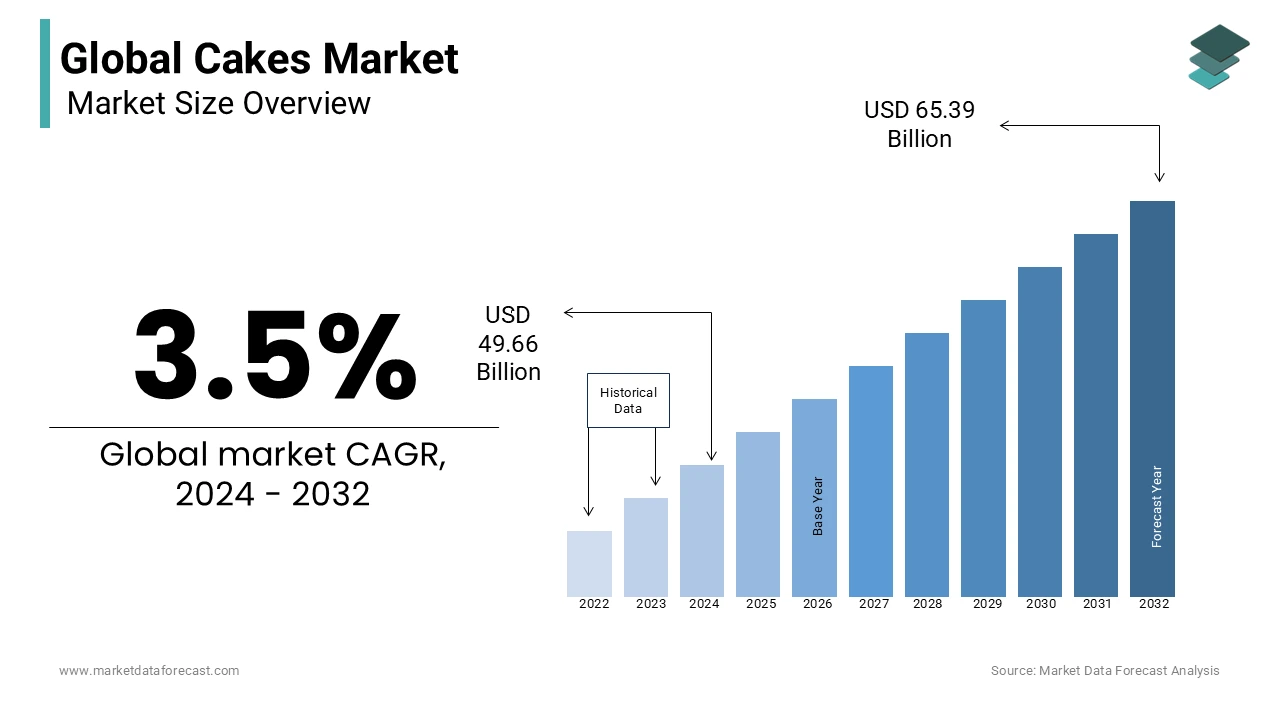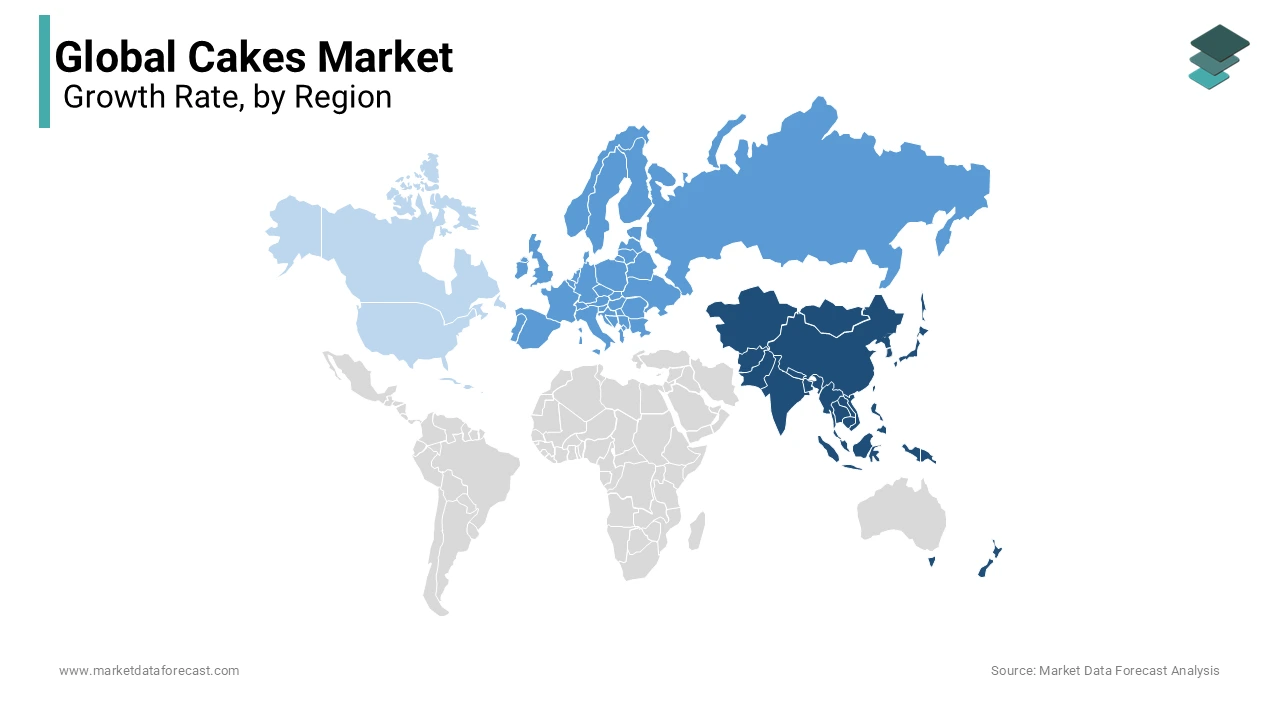Global Cakes Market Size, Share, Trends & Growth Forecast Report - Segmented By Type (Dessert Cake, Cheese Cake, Cup Cake And Wedding Cake), Mixing Method, Distribution Channel, And Region (North America, Europe, Asia Pacific, Latin America, and Middle East & Africa) – Industry Analysis (2025 to 2033)
Global Cakes Market Size
The size of the global cake market was valued at USD 49.67 billion in 2024, and the global market size is expected to reach USD 67.70 billion in 2033 from USD 51.41 billion in 2025. The market's promising CAGR for the predicted period is 3.5%.

Cakes are a type of baked confection created using ingredients including flour, sugar, butter, and others. The widespread use of cake as food to celebrate food on many special occasions is primarily responsible for the increase in cake consumption worldwide. Along with this, the expansion of the cake market has also been attributed to an increase in the consumption of cakes as post-meal desserts. Additionally, as customers' awareness of their own health has increased, they have begun to favor enriched cakes with high nutritional value. The global cake market has grown as a result of the growing number of working professionals and their increased appetite for quick meals such as muffins, sweet pies, and cupcakes. Additionally, the cakes market expansion has been aided by the manufacturers' introduction of new products to satisfy consumers' rising demand.
Current Scenario of the Global Cakes Market
The cakes market is growing at a steady pace. One of the factors influencing people to eat desserts is social media. Like Tik Tot people are surprised by the tremendous talents of foreign bakers. The small glance provided by these platforms into the most recent cake patterns is transforming and driving consumption. Moreover, another trend in the industry is the rise of Treat Baskets and Tray Bakes. Currently, worldwide, the revival of old-fashioned tray bakes is the newest pattern. The growing attraction towards the nostalgic feeling and charm of classic sheet cakes is assisting the market to grow forward. In addition, brownies and tray bakes are increasingly popular because they can be included in elegantly designed treat boxes.
Additionally, 2D Comics, Lambeth Style, Mini, Slogan and Dessert cups are the most trending cakes in 2023. Apart from this, another consumer preference is ordering trendy cakes for family and friends abroad has turned into a pleasant way to make up for the distance and share cultural experiences. Also, because of the growing accessibility of international cake-delivery services sending a bite of local flavour and style has become far simpler.
Another factor propelling the market forward is the extensive consumption of cakes and sweet dishes by American people whether it is cake pops, cupcakes, birthday cake, etc. However, Starbucks Cake Pops have spread across the United States in recent times. This is due to its simple logistics, unique taste and attractive design which has swiftly ascended to the top of the country’s food charts.
Besides all these, the rising cost of cakes and related items in 2023 and now to some extent has affected the market. The raw material prices have surged as compared to the previous years. For instance, single sized cake is spiked to 5.25 dollars from 4.50 dollars which is a 16 per cent growth.
MARKET DRIVERS
The enormous popularity of celebrating different kinds of important occasions and accomplishments through cake cutting is one of the key factors propelling the global cake market growth. The growing demand for cakes as sweets after meals during dine-out and weekend parties among millennials and Generation Z customers worldwide is also contributing to the growth of the global market. Birthdays, marriages, marriage anniversaries, Valentine's Day, Christmas, the birthday of a pet, a work anniversary, Mother’s Day, and children's Day are just a few examples of the unique occasions that are increasingly being celebrated around the world in recent years. The global cakes market's potential is developing as consumers spend more money on occasion-specific cakes. As a result of the immediate, easily accessible, and delicious nature of bakery items in today's increasingly urbanizing and evolving lifestyle, their demand is likewise rising dramatically across the globe. The demand for bakery goods, including cake, pastries, biscuits, and pita bread, has been particularly robust throughout Europe and North America.
The demand for cakes is also rising in developing economies in Asia and the Middle East due to the increased embrace of the Western lifestyle and diet. Due to shifting consumer preferences toward more complex baked options, the bakery business has been seeing fresh gains. For instance, it is anticipated that the growing popularity of Western-style bakeries in Asian nations like China, Japan, and South Korea will continue to have a positive impact. According to estimates, the Asia Pacific region generated about half of the worldwide sales in 2019. This presents enormous growth potential for both domestic and foreign bakers to introduce new types, including cakes and pastries.
MARKET RESTRAINTS
Complying with strict rules and disparate standards around the world, increasing competition, and inflation predicted to stay over the top band in key nations during the short term, and fluctuating raw material prices are some market limitations for the cakes market over the forecast period.
REPORT COVERAGE
|
REPORT METRIC |
DETAILS |
|
Market Size Available |
2024 to 2033 |
|
Base Year |
2024 |
|
Forecast Period |
2025 to 2033 |
|
CAGR |
3.5% |
|
Segments Covered |
By Product, Distribution Channel, and Region |
|
Various Analyses Covered |
Global, Regional & Country Level Analysis, Segment-Level Analysis, DROC, PESTLE Analysis, Porter’s Five Forces Analysis, Competitive Landscape, Analyst Overview of Investment Opportunities |
|
Regions Covered |
North America, Europe, APAC, Latin America, Middle East & Africa |
|
Market Leaders Profiled |
Finsbury Food Group Plc, Yamazaki Baking Co., Ltd, MCKEE FOODS, Grupo Bimbo, Bread Talk Group Limited, Hostess Brands, LLC, Monginis and George Weston Limited |
SEGMENTAL ANALYSIS
By Product Insights
The dessert cakes segment had a market share of 50.5% in 2023 and is anticipated to keep leading over the projection period due to their widespread fresh consumption on various occasions. Additionally, it is eaten as part of the dessert in many nations after meals.

With a CAGR of 3.7% during the forecast period, the sponge cakes segment is predicted to be the product category with the quickest growth. This is due to their increased appeal among young people around the world. Compared to other desserts, these sponge cakes have a long shelf life. These products can be enjoyed after a week in addition to when they are still fresh. As a result, the youthful population around the world is growing the demand for these products. Additionally, a few local players are well-known for their sponge cotton cakes in various Asian nations, like Japan and South Korea.
By Distribution Channel Insights
During the forecast period, the offline channels segment is anticipated to account for the majority of distribution channels. With a share of over 50.0% in 2019, specialty retailers became the market leader in this product category, and it is expected that they will continue to hold this position over the next years. Many domestic competitors have specialty shops where they sell a variety of artesian cakes, dessert cakes, and sponge cakes. Also widely accessible are cupcakes and other baked goods with a long shelf life in the biggest grocery chains, including Walmart, Sainsbury's, Tesco, 7Eleven, Apar, and Aldi. These wealthy business players are increasing their product offers in an effort to draw clients.
REGIONAL ANALYSIS
The Asia Pacific is experiencing rapid growth in the cakes market. This is because the consumption of cakes has drastically risen in the APAC region. And, this is particularly as more people in countries like Japan, China and India are adopting Western diets which is boosting cake sales. Also, Japan is famous for its minimalist method in different cakes like match (green tea), sakura (cherry blossom) and yuzu (fragrant citrus). Moreover, the art of cake decorating in Japan reflects its focus on delicacy and minimalism. At last, their simple yet beautiful designs are a common feature of their cake pattern. So, there is a huge potential for higher penetration along with an increase in per capita cake consumption in the APAC region. Also, the growing popularity of the newest organic flavours, vegan components and healthy and natural ingredients will boost consumption in developed countries. In Australia, the prevalence of “naked cakes” is high due to its least outer icing, layers and fillings which people like to flaunt. These are generally dressed with fresh fruits and flowers and give rural and inherent charm.

With a share of almost 30.0%, Europe was the second-largest regional cakes market in 2023. Several European nations, including Switzerland, Belgium, France, Italy and Austria are well known for their delectable baked goods and especially cakes. In addition, both native and foreign visitors demand a broad range of locally made cakes. Another important aspect boosting the regional market is the rise of food tourism. Similarly, the French entremets cake is swiftly becoming famous due to its multi layered mousse base with several corresponding textures and flavours.
The North America cakes market is dominated by the United States. Funfetti and confetti are widely popular in the country and are perceived as happiness and celebration. Further, these multicolour cakes give a fun and creative element to any event, occasion and party with sprinkles and rainbow baked inside.
KEY PLAYERS IN GLOBAL CAKES MARKET
Key players in globa cakes market are Finsbury Food Group Plc, Yamazaki Baking Co., Ltd, MCKEE FOODS, Grupo Bimbo, Bread Talk Group Limited, Hostess Brands, LLC, Monginis and George Weston Limited are some of the notable companies in the global cakes market.
RECENT HAPPENINGS IN THE MARKET
-
In April 2025, Rich Products made its Funfetti Ice Cream Cake item available in Publix, ShopRite, Kroger and independent convenience stores in over the United States.
-
In October 2023, revealed that it is introducing three new products in its cake portfolio. These are launched underneath their brands namely Plantastic and Mr Kipling. Moreover, it is devised to give a healthy variant of the Deliciously Good better-for-you cake product line with the inclusion of an extra Cherry Bakewell product. This Deliciously Good Bakewell includes 30 per cent less sugar.
MARKET SEGMENTATION
This research report on the global cakes market has been segmented and sub-segmented based on product, distribution channel & region.
By Product
- Cupcakes
- Dessert Cakes
- Sponge Cakes
By Distribution channel
- Offline
- Online
By Region
- North America
- Europe
- Asia Pacific
- Middle East and Africa
- Latin America
Frequently Asked Questions
1. Are There Healthier Options Available in the Cakes Market?
Yes, there are healthier alternatives in the cakes market, such as gluten-free cakes, sugar-free cakes, vegan cakes, and cakes made with natural or organic ingredients. These options cater to consumers with dietary restrictions or preferences.
2. Where Can I Find Specialty Cakes for Special Occasions?
Specialty cakes for weddings, birthdays, anniversaries, and other events can be found at local bakeries, patisseries, specialty cake shops, and online cake delivery services. Many bakeries offer customizable cakes to suit specific themes or dietary needs.
3. What Factors Influence the Price of Cakes?
The price of cakes can vary depending on factors such as size, complexity of design, ingredients used, customization, and the reputation of the bakery or brand. Specialty cakes and custom-designed cakes tend to be more expensive than standard options.
Related Reports
Access the study in MULTIPLE FORMATS
Purchase options starting from
$ 2500
Didn’t find what you’re looking for?
TALK TO OUR ANALYST TEAM
Need something within your budget?
NO WORRIES! WE GOT YOU COVERED!
Call us on: +1 888 702 9696 (U.S Toll Free)
Write to us: sales@marketdataforecast.com